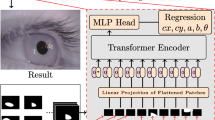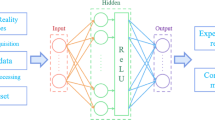Abstract
Robust and accurate pupil center detection is a prerequisite for eye-tracking system. In natural environments, due to rapid illumination transformation, pupil occlusion, specular reflection, etc., existing pupil detection methods are not easy to detect the pupil center robustly and accurately. To solve this problem, inspired by the multi-task auxiliary learning characteristic of human beings, we propose a coarse-to-fine pupil center detection method. We explore the hidden relationship between multi-task auxiliary learning characteristic and the pupil detection task. Our method can be divided into two stages, i.e., coarse classification and fine regression. Firstly, in the coarse classification stage, we use multiple subtasks to assist the main task so as to improve the robustness of the model. Secondly, in the fine regression stage, we use the main task from coarse classification to assist the regression task to improve the accuracy of the model. The results of the coarse classification stage are refined to determine the final accurate pupil center. The proposed method achieves 97% detection rate on LPW with a distance error lower than 5 pixels. In addition, our method also shows the state-of-the-art results on the ExCuSe, ElSe, and PupilNet datasets. Finally, a large number of experiments are taken to verify the effectiveness and advancement of the pupil center detection method inspired by the multi-task auxiliary learning characteristic.






Similar content being viewed by others
References
Alex K, Roberto C (2018) Multi-task learning using uncertainty to weigh losses for scene geometry and semantics 30–43 ar**v:1705.07115
Chen LC, Papandreou G, Schroff F, Adam H (2017) Rethinking atrous convolution for semantic image segmentation, pp 30–43. ar**v:1706.05587
Chen C, Wang J, Lin Y (2019) A visual interactive reading system based on eye tracking technology to improve digital reading performance. The Electronic Library 37:680–702
Chinsatit W, Saitoh T (2017) Cnn-based pupil center detection for wearable gaze estimation system. Appl Comput Intell Soft Comput 2017:1–10
Didday RL, Arbib MA (1975) Eye movements and A two visual perception: visual system model. Int J Man Mach Stud 7:547–569
Dowiasch S, Backasch B, Einhäuser W., Leube D, Kircher T, Bremmer F (2016) Eye movements of patients with schizophrenia in a natural environment. Eur Arch Psychiatry Clin Neurosci 266:43–54
Edewaard DE, Tyrrell RA, Duchowski AT, Szubski EC, King SS (2020) Using eye tracking to assess the temporal dynamics by which drivers notice cyclists in daylight: Drivers becoming aware of cyclists. In: ETRA ’20: 2020 symposium on eye tracking research and applications, pp 36:1–36:5
Eivazi S, Santini T, Keshavarzi A, Kubler T, Mazzei A (2019) Improving real-time cnn-based pupil detection through domain-specific data augmentation. In: Proceedings of the 11th ACM symposium on eye tracking research and amp applications, pp 40:1–40:6
Fang A, Zhao X, Yang J, Cao S, Zhang Y (2020) Ae-net: Autonomous evolution image fusion method inspired by human cognitive mechanism, 30–43
Fang A, Zhao X, Yang J, Zhang Y (2019) A cross-modal image fusion method guided by human visual characteristics. ar**v:1912.08577
Fang A, Zhao X, Yang J, Zhang Y (2019) Non-linear and selective fusion of cross-modal images. ar**v:1912.10738
Fang A, Zhao X, Zhang Y (2020) Cross-modal image fusion guided by subjective visual attention. Neurocomputing 49:26719–26730
Figueiredo GR, Ripka WL, Romaneli EFR, Ulbricht L (2019) Attentional bias for emotional faces in depressed and non-depressed individuals: an eye-tracking study. In: 41st annual international conference of the IEEE engineering in medicine and biology society, pp 5419–5422
Fuhl W, Kübler TC, Sippel K, Rosenstiel W, Kasneci E (2015) Excuse: Robust pupil detection in real-world scenarios. In: Computer analysis of images and patterns 16th international conference, vol 9256, pp 39–51
Fuhl W, Santini T, Kasneci G, Kasneci E (2016) Pupilnet: convolutional neural networks for robust pupil detection. Revista De Odontologia Da Unesp 19:806–821
Fuhl W, Santini T, Kübler T, Kasneci E (2016) Else: ellipse selection for robust pupil detection in real-world environments. In: Proceedings of the Ninth Biennial ACM Symposium on eye tracking research and applications, vol 14, pp 123–130
Gomolka Z, Kordos D, Zeslawska E (2020) The application of flexible areas of interest to pilot mobile eye tracking. Sensors 20:986–986
He K, Zhang X, Ren S, Sun J (2016) Deep residual learning for image recognition. In: 2016 IEEE Conference on Computer Vision and Pattern Recognition (CVPR), vol 2016, pp 770–778
Javadi A-H, Hakimi Z, Barati M, Walsh V, Tcheang L (2015) Set: a pupil detection method using sinusoidal approximation. Frontiers in Neuroengineering 8:4–4
Joo HJ, Jeong HY (2020) A study on eye-tracking-based interface for vr/ar education platform. Multim Tools Appl 79(23-24):16719–16730
Kang J, Han X, Song J, Niu Z, Li X (2020) The identification of children with autism spectrum disorder by SVM approach on eeg and eye-tracking data. Comput Biol Med 120:103722–103722
Kim HC, ** S, Jo S, Lee JH (2020) A naturalistic viewing paradigm using 360 degree panoramic video clips and real-time field-of-view changes with eye-gaze tracking. NeuroImage 216:116617–116617
Kirkpatrick J, Pascanu R, Rabinowitz N, Veness J, Desjardins G, Rusu AA, Milan K, Quan J, Ramalho T, Grabska-Barwinska A, Hassabis D, Clopath C, Kumaran D, Hadsell R (2017) Overcoming catastrophic forgetting in neural networks. Proc Natl Acad Sci U S A 114:3521–3526
Krizhevsky A, Sutskever I, Hinton G (2017) Imagenet classification with deep convolutional neural networks, 60:84–90
Lee GJ, Jang SW, Kim GY (2020) Pupil detection and gaze tracking using a deformable template. Multimed Tools Appl 79:12939–12958
Li H, Lin Z, Shen X, Brandt J, Hua G (2015) A convolutional neural network cascade for face detection. In: IEEE conference on computer vision and pattern recognition, pp 5325–5334
Li D, Winfield D, Parkhurst DJ (2005) Starburst: A hybrid algorithm for video-based eye tracking combining feature-based and model-based approaches. In: IEEE conference on computer vision and pattern recognition, pp 79–79
Lim JZ, Mountstephens J, Teo J (2020) Emotion recognition using eye-tracking: taxonomy, review and currentchallenges. Sensors 20:2384–2384
Long X, Tonguz OK, Kiderman A (2007) A high speed eye tracking system with robust pupil center estimation algorithm. In: 2007 29th annual international conference of the IEEE engineering in medicine and biology society, pp 3331–3334
Miller EK, Cohen JD (2001) An integrative theory of prefrontal cortex function. Annu Rev Neurosci 24:167–202
Park H, Lee S, Lee M, Chang MS, bWan Kwak H (2016) Using eye movement data to infer human behavioral intentions. Comput Hum Behav 63:796–804
Riba P, Llads J, Forns A (2020) Hierarchical graphs for coarse-to-fine error tolerant matching. Pattern Recognit Lett 134:116–124
Ruiz N, Chong E, M Rehg J (2018) Fine-grained head pose estimation without keypoints. In: 2018 IEEE conference on computer vision and pattern recognition, pp 2074–2083
Ryan WJ, Duchowski AT, Birchfield ST (2008) Limbus/pupil switching for wearable eye tracking under variable lighting conditions. In: Proceedings of the eye tracking research and application symposium, pp 61–64
Santini T, Fuhl W, Kasneci E (2018) Pure: Robust pupil detection for real-time pervasive eye tracking. Comput Vis Image Underst 170:40–50
Simonyan K, Zisserman A (2015) Very deep convolutional networks for large-scale image recognition. In: 3Rd international conference on learning representations, ar**v:1409.1556
Strnádelová B, Halamová J, Kanovský M (2019) Eye-tracking of facial emotions in relation to self-criticism and self-reassurance. Appl Artif Intell 33:839–862
Szegedy C, Liu W, Jia Y, P. S. et al (2015) Going deeper with convolutions. In: 2015 IEEE conference on computer vision and pattern recognition, pp 1–9
Świrski L, Bulling A, Dodgson N (2012) Robust real-time pupil tracking in highly off-axis images. In: Proceedings of the symposium on eye tracking research and applications, pp 173–176
Valenti R, Gevers T (2012) Accurate eye center location through invariant isocentric patterns. IEEE Trans Pattern Anal Mach Intell 34:1785–1798
Vera-Olmos F, Pardo E, Melero H, Malpica N (2019) Deepeye: Deep convolutional network for pupil detection in real environments. Integrated Computer-Aided Engineering 26:85–95
Wang Y, Liang W, Shen J, Jia Y, Yu L (2019) A deep coarse-to-fine network for head pose estimation from synthetic data. Pattern Recognit 94:196–206
Wang X, Zhao X, Ren J (2019) A new type of eye movement model based on recurrent neural networks for simulating the gaze behavior of human reading. Complexity 2019:12–12
Zhang J, Mei K, Zheng Y, Fan J (2019) Learning multi-layer coarse-to-fine representations for large-scale image classification. Pattern Recognit 91:175–189
Zhang Y, Yang Q (2018) An overview of multi-task learning. Nat Sci Rev 5:30–43
Zhou X, Gao X, Wang J, Yu H, Wang Z, Chi Z (2017) Eye tracking data guided feature selection for image classification. Pattern Recognit 63:56–70
Acknowledgements
This work was supported by the National Natural Science Foundation of China under Grants Nos. 61871326, and the Shaanxi Natural Science Basic Research Program under Grants Nos. 2018JM6116, and Science and Technology on Electro-optic Control Laboratory Jointly funded with Aviation Science Fund under Grants Nos. 20185153031.
Author information
Authors and Affiliations
Corresponding author
Additional information
Publisher’s note
Springer Nature remains neutral with regard to jurisdictional claims in published maps and institutional affiliations.
Rights and permissions
About this article
Cite this article
**ang, Z., Zhao, X. & Fang, A. Pupil center detection inspired by multi-task auxiliary learning characteristic. Multimed Tools Appl 81, 40067–40088 (2022). https://doi.org/10.1007/s11042-022-12278-4
Received:
Revised:
Accepted:
Published:
Issue Date:
DOI: https://doi.org/10.1007/s11042-022-12278-4




